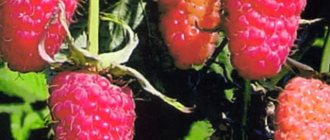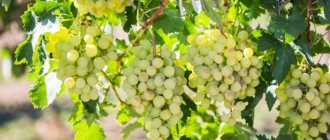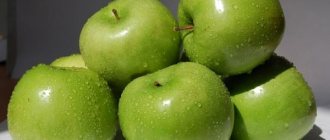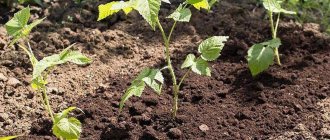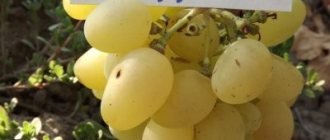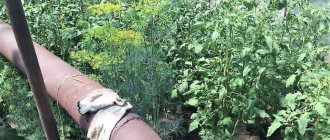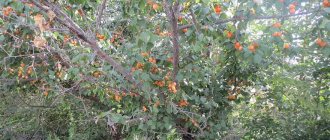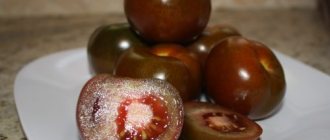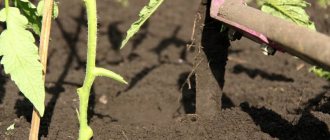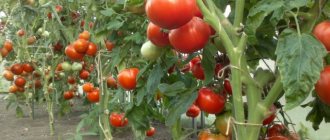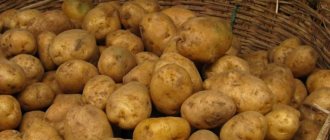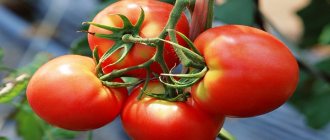- December 9, 2018
- Vegetables
- Ekaterina Ryzhkova
Have you ever heard of a determinate tomato variety? What it is? You will find answers to these and other questions in the article. Today, choosing the best varieties of tomatoes for your garden is not easy. Shop windows are full of attractive pictures, and almost every bag indicates that this variety is the most appetizing, productive and large. And on the packaging you can find such long and intricate phrases as “determinate variety” and “indeterminate.” What does it mean? What is the difference? Let's find out below.
Indeterminate varieties
This is the name given to hybrids and varieties of unlimited growth. If you are familiar with the situation when a tomato bush rests against the roof of the greenhouse, but still grows and sets trusses to the last, then you have planted a tall (indeterminate) variety.
In a suitable climate, such varieties can grow for more than a year, reach a height of 2-3 m and produce up to 50 bunches of fruit.
Indeterminate varieties begin to bloom after the 9-12th leaf, flower clusters are formed every three leaves. The age for seedlings is 60-65 days; the plant begins to bear fruit in 100-130 days.
Determinate varieties of tomatoes: classification
All varieties of tomatoes belonging to the determinate variety are conventionally divided into 4 main subspecies. They all differ in their external characteristics, characteristics of growth and care.
Semi-determinant
Tomatoes grow up to 2 m, the bushes require mandatory staking and periodic pruning for productive growth. The first inflorescences are formed after 8 leaves on the main stem and after 4 on the lateral ones.
During the growing season, about 12 clusters are formed, after which the stem stops growing. Next, the brushes are formed after 2-3 sheets.
Determinate tomatoes
Have you ever grown determinate varieties of tomatoes? What is it? Unlike those touched upon above, these varieties and hybrids cannot grow immensely. They create a set number of brushes (from 4 to) and complete their growth.
What is it? Unlike those touched upon above, these varieties and hybrids cannot grow immensely. They create a set number of brushes (from 4 to) and complete their growth.
Determinate tomatoes, in turn, are divided into medium-growing and standard (low-growing). Standard varieties are the earliest, low, with a thick stem. Seedlings are good when they are 50-55 days old; after 90-100 days they enter the fruiting phase, but give a richer harvest (up to 8 clusters per bush).
The first flower cluster in determinate tomato varieties develops after the 5-7th leaf. After brushes are formed every 2 sheets.
Main differences between varieties
Describing the differences between these types of tomatoes will help you choose from the many varieties that will best suit your needs and expectations.
What does “determinant” and “indeterminate” mean?
All plants that have restrictions in their growth are classified as determinant. In contrast, tall ones are called indeterminate.
Determinate tomatoes are varieties of tomatoes that grow to a maximum of 70 cm and stop growing with the formation of a fruit ovary at the end of the main shoot. Further development occurs on the side shoots (stepchildren).
What are indeterminate tomatoes? The fruits of these crops are placed on a central stem, which reaches 2-4 m in height.
We distinguish varieties at all stages of growth
The question is relevant if the seeds or seedlings were given to you by the friendly owner of a neighboring summer cottage and you do not know exactly what category the plants belong to.
Seeds
At the seed selection stage, you will have to trust the manufacturer: the packaging contains characteristics of the variety. Gardeners prefer hybrid varieties. The selection of hybrids specifically provides for a set of certain qualities. Therefore, unlike pure varieties, they are most resistant to common diseases and are adapted to grow in certain climatic conditions.
Shoots
By the first sprouts you can already determine which variety they belong to. The height of the stem from the root to the cotyledon of a determinate tomato is 1-2 cm, of an indeterminate one - up to 5 cm.
Mature bushes
The length of the stem is not the main difference between an adult plant. There are tall determinate varieties intended for cultivation in greenhouses. Indeterminate standard ones, on the contrary, are characterized by short stature.
A sure sign that determines membership in the categories of interest to us will be the shape of the tomato bush. A formed brush at the top of the shoot and the formation of several inflorescences at the same time indicate a determinate type of tomato. In indeterminate crops, the ovaries are grouped around the central stem along its entire length.
Which ones are better?
Few people know about the properties of determinate tomato varieties. "What is it?" - people often ask themselves. Let's find out which variety is better to choose. It all depends on the purpose for which you cultivate tomatoes and how much work you are willing to put into them.
The basic advantage of indeterminate varieties is that their fruiting is extended. They give away the harvest in parts throughout the season. With good care, you can remove a bucket of fruits and even more from each bush. But these tomatoes require strict shaping into one stem, constant gartering and proper elimination of excess leaves and shoots.
Medium-sized determinate varieties begin to bear fruit earlier and yield more consistently. They are tied only once, and then formed into two stems (other stepsons are also removed). They do not create a “jungle” in the greenhouse, they are more compact, and their flower clusters are more likely to form.
Determinate varieties of tomatoes can also produce a harvest of up to a bucket per bush, but only with excellent care. Standard hybrids and varieties will delight you with the first tomatoes in June. They do not require pinching or staking; they grow great in pots: you won’t spend a lot of time and effort on them.
But there is still a minus: these plants will give one tiny harvest, and that will be the end of it. Therefore, before purchasing any variety, think about why and how many tomatoes you need: for canning, for eating in the summer months, or just to pamper yourself.
Determinate and indeterminate tomatoes: which varieties are better
During the course of the article, it became clear what determinate tomatoes are and what an indeterminate variety is. It is very difficult to choose the best one. Comparing varieties of varieties gives an idea of their characteristics, pros and cons. Determinate and indeterminate modern tomato varieties are suitable for certain climatic zones and have different yield rates.
If a bountiful harvest is important, an indeterminate tomato is the most profitable to grow. If it is necessary for a friendly and early harvest, preference is given to determinate type tomatoes, but the yield and size of the fruit will be less.
It is necessary to approach the choice of variety consciously. To try the fruits and find out what kind of indeterminate tomato it is, you will have to make every effort, but it will pay off with an “outlandish” harvest. But determinate varieties will also require some effort and will bring early harvest and health benefits.
Growing conditions
Everyone should know about the existence of determinate varieties of tomatoes. You already know what it is. When purchasing seeds of such varieties, you need to take into account the cultivation conditions (indoor or open ground) and the climatic zone. It is impossible to do without this.
In the northernmost regions there is no point in growing tomatoes in open ground. There, determinate varieties of tomatoes are chosen for greenhouses. During the short summer they manage to give away their entire harvest.
In the Middle Zone, experienced summer residents advise cultivating determinate plants in open ground, and indeterminate plants in protected ground. In the southern regions, you can safely plant indeterminate tomatoes both outdoors and in a greenhouse.
For open ground
"Sanka"
Very early, 30-60 cm high. The fruit is round, slightly ribbed red. Resistant to cracking. It develops and bears fruit well in low light and low temperatures. More about the Sanka tomato
"Alpha"
Can be planted directly into the ground, bypassing the seedling stage. In the south, the fruits ripen in early summer, in the north - in mid-July. The period from planting to ripening is 85 days. The variety is resistant to diseases. The fruits do not tolerate transportation well.
“Superbomb” Mid-season new product for open ground. Resistant to weather changes. Requires intensive feeding and pinching. The fruits are large, fleshy, 5-6 per cluster. Gives a decent harvest in open ground.
"Explosion Hybrid"
Superdeterminate hybrid of tomatoes, can be grown without seedlings. Not afraid of frost and sudden temperature changes. It grows poorly in greenhouses.
Seedling age
Surely you remember that determinant means short. If you decide to buy varieties from different subspecies, be sure to pay attention to the recommended age of the seedlings. It is different for tall, short and medium-growing varieties.
This means that in order to obtain the maximum yield, seeds must be planted systematically. From the planned date of planting seedlings in a permanent place, it is necessary to subtract the recommended age and add five to seven days for the emergence of seedlings. For example, if you usually plant tomatoes in a greenhouse in early May, then tall tomatoes should be planted as seedlings in the first days of March, standard tomatoes at the end of the month, and medium-sized tomatoes in the middle.
Remember that if you sow seeds for seedlings too early, this will deprive the plants of energy ahead of schedule. If it is too late, they will not be able to realize their full potential.
Popular varieties of indeterminate tomatoes
- Octopus. This is a real leader among indeterminate tomatoes. It has dark red fruits, its distinctive feature is the absence of green spots near the stem. This is one of the year-round varieties, ideal for growing in greenhouse conditions. If you provide him with good conditions, you can grow several harvests a year.
- Major. This is a sought-after variety that attracts gardeners with its very sweet sugar fruits. Thanks to the dense pulp, the fruits easily tolerate transportation, which explains the popularity of the variety in commercial cultivation. Due to the very pleasant taste of the pulp, tomatoes of this variety are constantly used for salads. The color of the fruit is pink, the plant calmly tolerates temperature fluctuations and is not afraid of many diseases.
- Happiness is a tomato variety with large red fruits that have a pleasant smell. Due to the large size of the bush, this variety is preferable to choose for large greenhouses; the bush will grow very quickly. Vigorous growth ensures rapid flowering and fairly early fruit ripening.
- Russian happiness is a variety of the above-mentioned variety. It is characterized by shorter distances between nodes. Because of this, the growth of the bush is smaller, and it is easier for it to find a place in a regular greenhouse. The fruits have another important advantage: they do not crack during transportation and storage, which ensures their preservation for a longer time.
These are just some varieties; the choice for gardeners is much wider. When buying seeds, you need to pay attention to the inscriptions on the back of the bag of seeds: it not only indicates the type of variety, but also indicates basic recommendations for growing.
The best low-growing varieties
And yet, a determinate plant - what does it mean? This denotes the strength of its growth. For better understanding, some seed manufacturers and sellers simply write “stunted” on the packaging. Indeterminate – “tall”, respectively.
Tomatoes of super-determinate varieties do not need to be pinched. But ordinary determinate bushes still require little care. After all, it is impossible for the plant to be overloaded with fruits. In general, these varieties are famous for their early and friendly harvest.
The best determinate varieties of tomatoes for greenhouses are:
- Dwarf;
- Grotto;
- Delicacy;
- Aurora;
- Golden heart;
- Balcony miracle;
- Alpha;
- Yamal;
- Oak;
- Grandee;
- Amur dawn;
- Betalux;
- Cameo;
- Harem;
- Sultan;
- Siberian early ripening;
- Alaska and so on.
The best indeterminate varieties
Did you buy a determinate variety of tomatoes? You already know what it is. Try growing an indeterminate variety in a greenhouse. Such a plant can grow for more than a year continuously, as we discussed above. In northern latitudes, it is difficult to cultivate such a tomato, as it requires a lot of light and heat. But if you have a specially equipped greenhouse, then you can take the risk. For greenhouses, the best indeterminate varieties are:
- La Bayadère;
- Chinese pink;
- Black Prince;
- Bravo;
- Wild Rose;
- Admiral;
- De Barao;
- Red pepper;
- Pink Giant;
- Orange;
- Pink peppercorn;
- Bull's Heart;
- Vlad;
- Yellow Giant;
- Caliber;
- Tarasenko anniversary;
- The ox heart is pink and red;
- Intuition;
- Wren;
- Aristocrat.
In general, it is difficult to say which varieties are worse and which are better. Everyone chooses not only according to their own taste properties, but also according to the area of growth. It is also very important where the tomato will grow: in a greenhouse or open ground. Therefore, any variation can be useful when growing. By the way, you can cultivate different types of tomatoes in one area.
The main differences between determinate and indeterminate and other tomatoes
Sometimes seed sellers indicate in the annotation: low-growing, medium-growing or tall-growing. This definition is erroneous and misleading to inexperienced gardeners. Among the indeterminate varieties there are low-growing ones. Determinate tomatoes, bred specifically for growing in greenhouses, are distinguished by tall stems.
The main difference is not the height of the plant, but its development during the formation of flower clusters. Indeterminate tomatoes grow upward and bear fruit throughout the season. Determinate ones have the peculiarity of stopping growth when a certain number of inflorescences are formed.
Tips from skilled gardeners
If you want to stimulate fruiting of tomato bushes, place buckets of fermenting grass or manure in the greenhouse. Fermentation will increase the concentration of carbon dioxide in the air. When the atmosphere contains a lot of carbon dioxide, the fruits grow larger.
To increase the parameters of tomatoes from determinate varieties, it is necessary to cut a couple of ovaries from each bunch. The remaining fruits will grow more actively and will come out twice as large as usual. Experienced vegetable growers talk about tomatoes weighing 1 kg. But if there are fishing and hunting bikes, then why not garden bikes? Of course, if we are not talking about large-fruited varieties.
In a greenhouse, it is better to cultivate several varieties simultaneously, including both indeterminate and determinate varieties. In addition to variety, this technique guarantees a good harvest.
If the bushes do not flower very actively, remove the lower ovaries. A bush freed from excess load will later produce twice as many tomatoes.
There are a huge variety of tomato varieties. In search of the best variety, you can experiment for years. Or you can plant a couple of varieties at the same time and then settle on the ones you like the most.
What is the difference between determinate and indeterminate tomatoes?
So, let’s summarize the main differences between indeterminate and determinate tomatoes:
- Seedlings. When shoots appear after 3-4 days, the cotyledon knee straightens and by its length you can indirectly determine the type of future bush. In indeterminate varieties it is longer (3-5 cm) than in determinate varieties (1-3 cm). However, with a lack of light, the seedling can become very elongated and then it is quite difficult to determine what kind of bush it will be.
- Seedling. When the seedlings reach the age of appearance of the first flower cluster, you can easily determine the type of future bush. Indeterminate tomatoes form the first cluster after 8-9 true leaves and above, determinate - after 6-7 true leaves and below.
- Mature plants. When a plant has been planted for a long time, has grown well and has several clusters of fruits, it is difficult to determine the number of leaves before the first ovary, since the seedlings could have been buried and part of the stem remained underground.
Indeterminate varieties plant flowers through 3 leaves. Determinate tomatoes always have less than 3 true leaves between the trusses. On a plant of determinate varieties you can always find a shoot whose growth ends at the ovary; in indeterminate varieties this will not happen. The only mistaking an indeterminate tomato for a determinate one can be when, during the formation of the plant, the shoot is pinched immediately behind the flower raceme and it seems that the shoot has finished growing on it. Therefore, you need to be careful and count the leaves between the ovaries as a check.
Nuances
The growth of indeterminate tomatoes should be limited mechanically. Since our warm season is short and the fruits above the 2 m mark will not have time to ripen, remove the top already at this height.
Standard tomatoes are cultivated in large areas for further processing or sale. They have a thick stem, do not require garter, and the first fruits are harvested on the 75th day after germination of the seedlings.
Semi-determinate tomatoes do not stop at a meter high and continue to grow. But growth can stop at any time. They are grown in two stems and are suitable for greenhouse conditions.
Disadvantages of indeterminate tomatoes
- It is necessary to have supports for the plant. Otherwise, it will lie on damp ground, which will lead to rotting of the fruit.
- Fruit ripening takes longer. This variety requires a long summer period or additional lighting and heating.
- The need to perform stepsoning. It is necessary to constantly remove stepsons on the plant so that they do not overload it.
Inconsistencies
The difference between the bushes becomes noticeable at the stage of seedling cultivation. In tall ones, on the 4th day after pipping, the cotyledonous knee can be seen. A little later, in indeterminate varieties, the first ovary appears above the 9th leaf, and in low-growing ones - after the 5th. Seedlings of determinate tomatoes begin to form a flower cluster when there are 5 leaves.
The formation of a tomato bush is also significantly different: tall ones create one stem, and short ones create two or three. Indeterminate plants produce crops along the entire height of the stem.
What is included in the concept of a determinate variety?
Determinant is a concept from linear algebra.
Its literal translation means “determinant”. When applied to plants, the name determinant means definite. growth stops with the appearance of a flower cluster at the top.
For gardeners who do not strive to grow tomatoes on an industrial scale and want to get an early harvest, determinate tomatoes are the ideal choice.
If the goal is to get as many fruits as possible, the choice is indeterminate (unlimited growth) varieties.
Find out more in the video below:
Growing seedlings of low-growing varieties
Low-growing varieties of tomatoes are planted in the first days of April. Seedlings are grown in wooden boxes. When the second and third leaves appear, the plant is sent to the greenhouse.
Tomatoes are fed with various versions of slurry in small volumes. Plants need to be molded only in special conditions with optimal temperature and humidity. Determinate tomatoes are unpretentious, but soil is of great importance for them, especially at the beginning of growth.
Before planting, it is treated with bleach dissolved in water. An excellent option would be the soil on which cucumbers were previously cultivated. To do this, you need to remove the top 10 cm layer of soil and lay cucumber soil. Next, place the hay and compost in a 15 cm layer.
For the cultivation of low-growing tomatoes, good conditions can be created using hay that has burned between two layers. Renew the soil annually, add layers of hay and apply protective sprays against insects.
Do not add manure to the soil under any circumstances, as this may cause the plants to become fattened. If the leaves become thick, the ovaries will be tiny and the yield will decrease. Also add ash, superphosphates and lime to the soil in the fall.
Features of cultivation
Caring for determinate and indeterminate tomatoes has some differences.
Location in a greenhouse or garden bed
It is advisable to grow indeterminate varieties of tomatoes in a high greenhouse (up to 2 m). Having a long fruiting period, they produce crops most of the year.
Important! Regular ventilation of the greenhouse will create optimal conditions for pollination and protect tomatoes from barren flowers.
Determinate and low-growing standard varieties of indeterminate tomatoes are more suitable for growing in open ground.
Seedling care
An error in the timing of planting and placing seedlings on the site, or ignorance of the rules for caring for them can minimize the result of your efforts.
Sowing time
Planting tomatoes in the ground or greenhouse is preceded by growing seedlings. Seeds of indeterminate varieties are sown in early March. After 65-75 days, the seedlings are ready to move to the garden bed.
Determinate varieties are sown at the end of March. The ripening time of seedlings is 55-60 days.
Important! The optimal soil temperature for planting tomatoes is not lower than 15°C.
Stepsoning
When caring for tomatoes, it is important to promptly remove from the bush non-fruit-bearing branches (stepchildren) located between the base of the leaf and the main stem. This agronomic technique (pinching) is aimed at eliminating the irrational distribution of nutrients by the plant. Proper formation of the bush increases productivity.
Indeterminate varieties need pinching to a much greater extent than their low-growing counterparts. Remove excess shoots every ten days throughout the growing season. The stepsons are carefully broken off, leaving a stump 1-2 cm high. Next, the bush is formed in one of the following ways: only the central stem with fruit clusters is left, or the most developed stepson is chosen as the main one.
Important! Having chosen the stepson as the main shoot, after the formation of fruit ovaries on it, pinch the former main stem (pruning is not recommended). This will stop its further growth.
Determinate tomatoes are not prone to uncontrolled growth of green mass. For them, stepsoning is greatly simplified. Since the main harvest comes from the first three inflorescences, the process is aimed at accelerating their ripening. It is enough to remove all the stepsons below the branch on which the ovaries formed. The lower two stepsons should be left, otherwise the plant will stop developing and stop bearing fruit. This type of bush formation is called “three stems” and is recommended for determinate varieties.
Important! The efficiency of the process will increase if the stepsons to be removed are not allowed to grow larger than 7 cm.
Planting in a greenhouse
Tomatoes are a flexible crop that takes root easily. Therefore, they can be planted in a greenhouse in different ways. An unrooted stepson can immediately take root even without proper care. If you plant medium-sized determinate tomato crops in a greenhouse, they will regulate their growth themselves. In the process of forming 4-5 inflorescences on the main shoot, their growth and topping stops. The branch part is created after the sixth leaf.
The plant is first grown in pots with enough space for the roots to fully develop. Different varieties can be planted both in furrows and in holes to a depth of 15-17 cm, leaving the top with a pair of leaves on the surface.
Growing and caring for crops
Determinate plant culture requires special care.
Transplanting
Planting of seedlings is carried out 60-65 days after preliminary germination.
How the process works step by step:
- Gardeners dig holes at a distance of up to 50 cm from each other.
- They are treated with mineral fertilizers with a large amount of potassium or sodium in the composition.
- Plant the seedlings and compact the soil tightly.
After planting, it is necessary to water abundantly.
Hilling
Hilling helps create a water reserve, strengthen the plant’s root system, and saturate the soil with oxygen. The procedure is carried out at the initial stages of the growing season, when rudimentary pimples form on the leaves and bushes.
Before hilling, it is necessary to thoroughly water and also add peat mixture or compost to the soil. If you perform the process in poorly moistened soil, you can damage the root system of tomatoes. Next, using a hoe, you need to sprinkle the bushes, first on one side and then on the other.
Watering
Determinate tomatoes do not require abundant and regular watering. Excessive humidity can harm plants and contribute to the development of rot. The procedure is carried out once a week during active growth, once every 2 weeks at the beginning of the growing season.
Important! In the process, you need to use liquid at room temperature.
Top dressing
Plants need regular feeding with mineral and organic fertilizers.
- During the formation of leaves and stems, it is recommended to focus on nitrogen and phosphorus fertilizing.
- During the formation and filling of fruits, preference is given to preparations with phosphorus and potassium.
- After harvesting, tomatoes are not fertilized.
Feeding determinate vegetables
Stepsoning
Stepping involves the timely removal of side shoots up to 2 cm in size. The procedure must be carried out during the period of active growth and formation of bushes.
Growing indeterminate varieties
Tie the trunks of tall tomatoes vertically. As a result, many brushes will appear on the plant, and in a small area you will reap a rich harvest: up to 16 kg per 1 m².
These varieties are less susceptible to disease. They must be tied to a trellis, removing the lower leaves and stepsons. This is necessary for good air circulation and uniform lighting.
Advantages and disadvantages of each of these types
Determinant
Advantages
- Early ripening variety;
- Early yield;
- The formation, growth and ripening of all fruits of the bush are not extended over a long period.
Flaws
- Relatively low overall yield compared to other species due to the limited growth of the bush;
- To improve productivity, frequent mineral fertilizing is required;
- It is necessary to regularly trim the bushes 3 times a month;
- Predisposition to diseases characteristic of tomatoes.
Reference! Determinate varieties are less productive than indeterminate varieties.
List of varieties:
- White filling;
- Demidov;
- Gina TST;
- La La Fa;
- Honey-sugar;
- Nevsky;
- Rocket.
Indeterminate
Advantages
- The ability to harvest a good harvest in small areas;
- Resistance to tomato diseases;
- Long-term fruiting (sometimes until October);
- Comfortable harvesting, it can be harvested while standing (tall bushes).
Flaws:
- The need to install supports for bushes;
- They require a long warm period, which is why they are more suitable for the southern regions;
- Removing stepchildren is of great importance, since bushes should be formed exclusively into 1 stem.
List of varieties:
- Ox heart;
- Marshmallows in chocolate;
- Christina plume;
- Right size;
- Star Gold;
- Cherokee;
- Miracle of the Earth.
Standard
Advantages:
- Low and strong stem, no garter required;
- The shallow location of the root system allows the plant to effectively absorb nutrients from the upper layers of the soil that come in the process of watering and fertilizing tomatoes;
- Dense planting of bushes is acceptable;
- Tolerates temperature changes and drought well;
- Rapid growth of vegetative mass without additional effort;
- The absence of stepchildren reduces labor costs for care;
- Long shelf life of fruits;
- The fruits do not spoil during transportation.
Reference! It should be noted the low growth of standard varieties, due to which they do not need to be tied up.
disadvantages , however, we note that these plants require frequent watering, since their root system is located close to the soil surface.
List of varieties:
- Alpha;
- Amur standard;
- Antoshka;
- Cheerful gnome;
- Gavroche;
- Far North;
- Standard Buyan.
When choosing the type of variety that you plan to grow, you should carefully study the positive and negative aspects of the varieties described above.
Watch the video! Determinate and indeterminate varieties of tomatoes
How to treat tomatoes?
To protect plants from fungal infections and other ailments, gardeners use special preparations: “Tattu”, “Ridomil Gold”, “Aliette”, “Infinito”.
It is known that tomatoes sometimes suffer from blossom end rot, which is one of the most dangerous diseases for them. Because of it, the tops of plants turn black. They fight the disease by spraying the seedlings with calcium nitrate at the time of planting.
Among insects, the following pests are dangerous for tomatoes: aphids, fall armyworms, and Colorado beetles. You can protect plants from them by using “Confidor”, “Act Ovit”, “Fitoverm”. To remove aphids, direct a strong stream of water to the area where they accumulate and wipe the leaves with ash.
